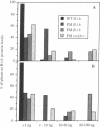Abstract
Increased expression of the insect control protein genes of Bacillus thuringiensis in plants has been critical to the development of genetically improved plants with agronomically acceptable levels of insect resistance. The expression of the cryIA(b) gene was compared to partially modified (3% nucleotide difference) and to fully modified (21% nucleotide difference) cryIA(b) and cryIA(c) genes in tobacco and tomato. The modified genes increased the frequency of plants that produced the proteins at quantities sufficient to control insects and dramatically increased the levels of these proteins. Among the most highly expressing transformed plants for each gene, the plants with the partially modified cryIA(b) gene had a 10-fold higher level of insect control protein and plants with the fully modified cryIA(b) had a 100-fold higher level of CryIA(b) protein compared with the wild-type gene. Similar results were obtained with the fully modified cryIA(c) gene in plants. Specific sequences of the partially modified cryIA(b) gene were analyzed for their ability to affect cryIA(b) gene expression in tobacco. The DNA sequence of a single region was identified as important to the improvement of plant expression of the cryIA(b) gene. The increased levels of cryIA(b) mRNA were not directly proportional to the increased levels of CryIA(b) protein in plants transformed with the modified cryIA(b) genes, indicating that the nucleotide sequence of these genes had an effect in improving their translational efficiency in plants.
Full text
PDF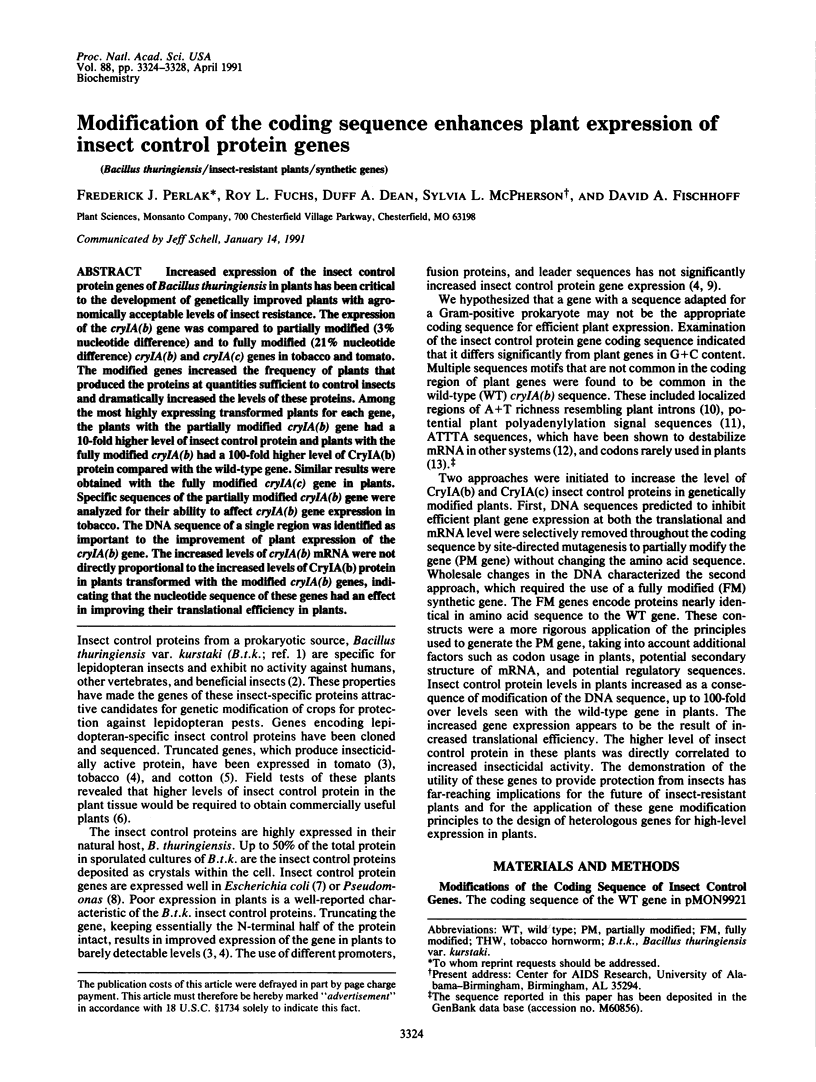
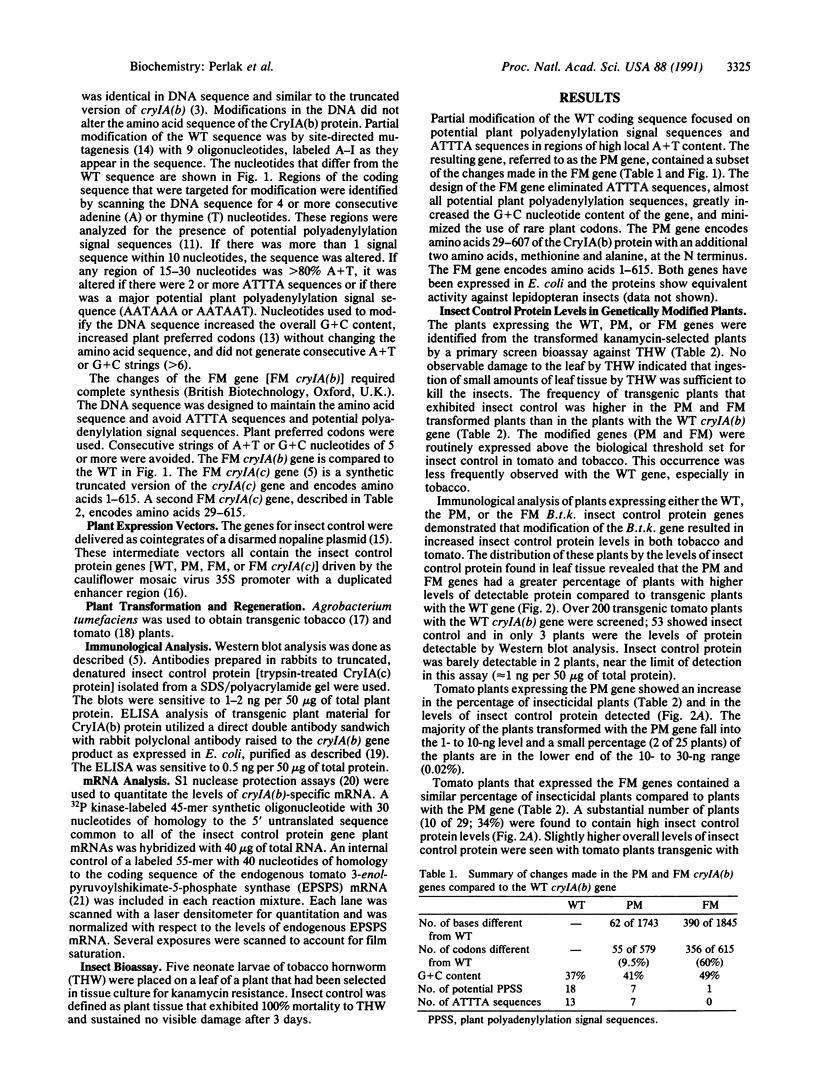
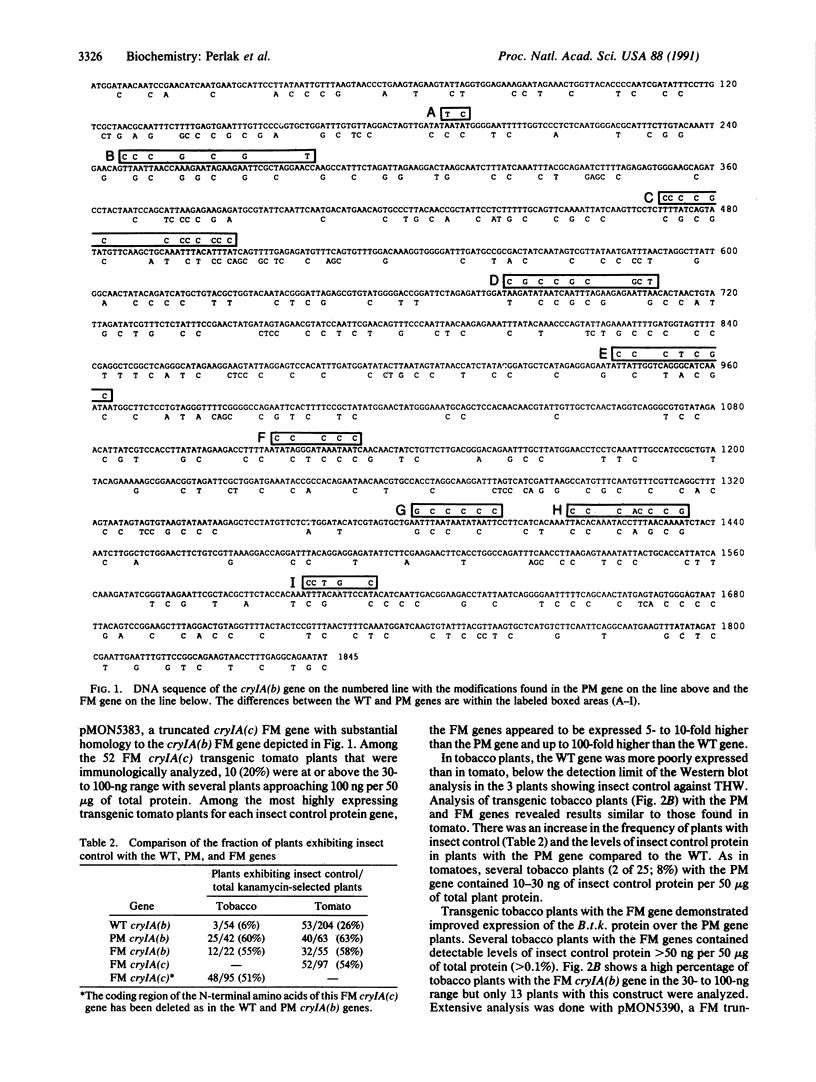
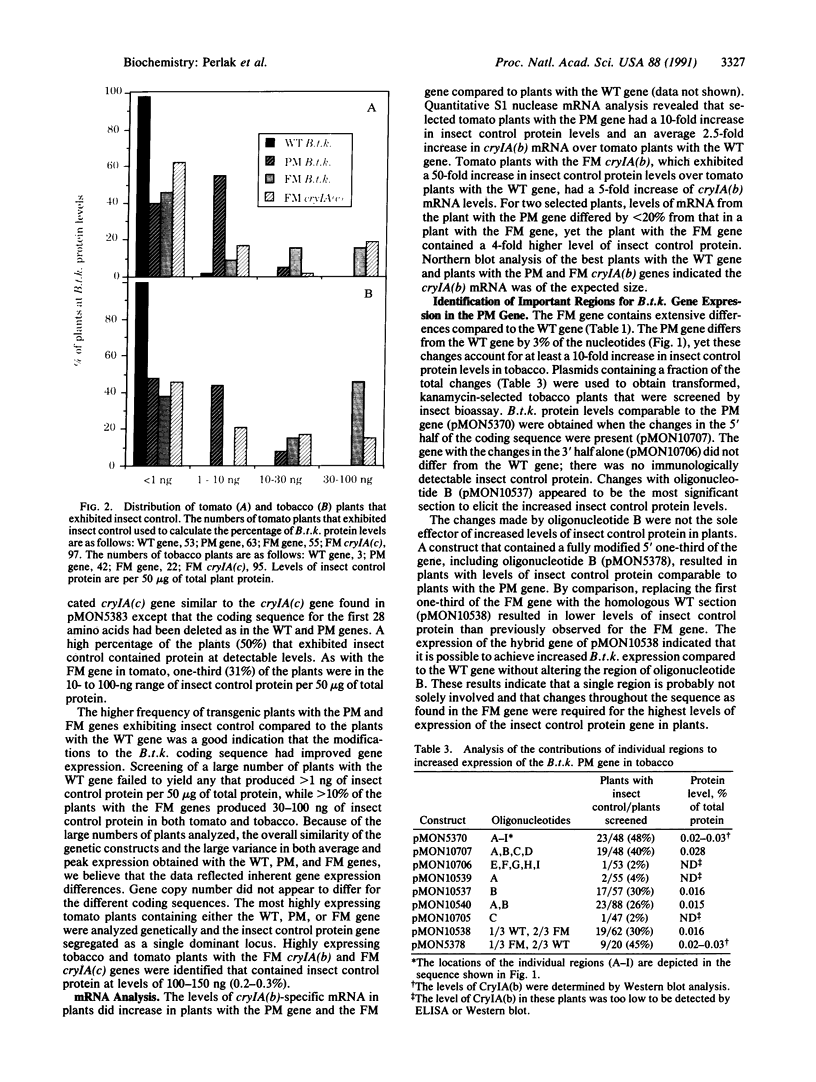
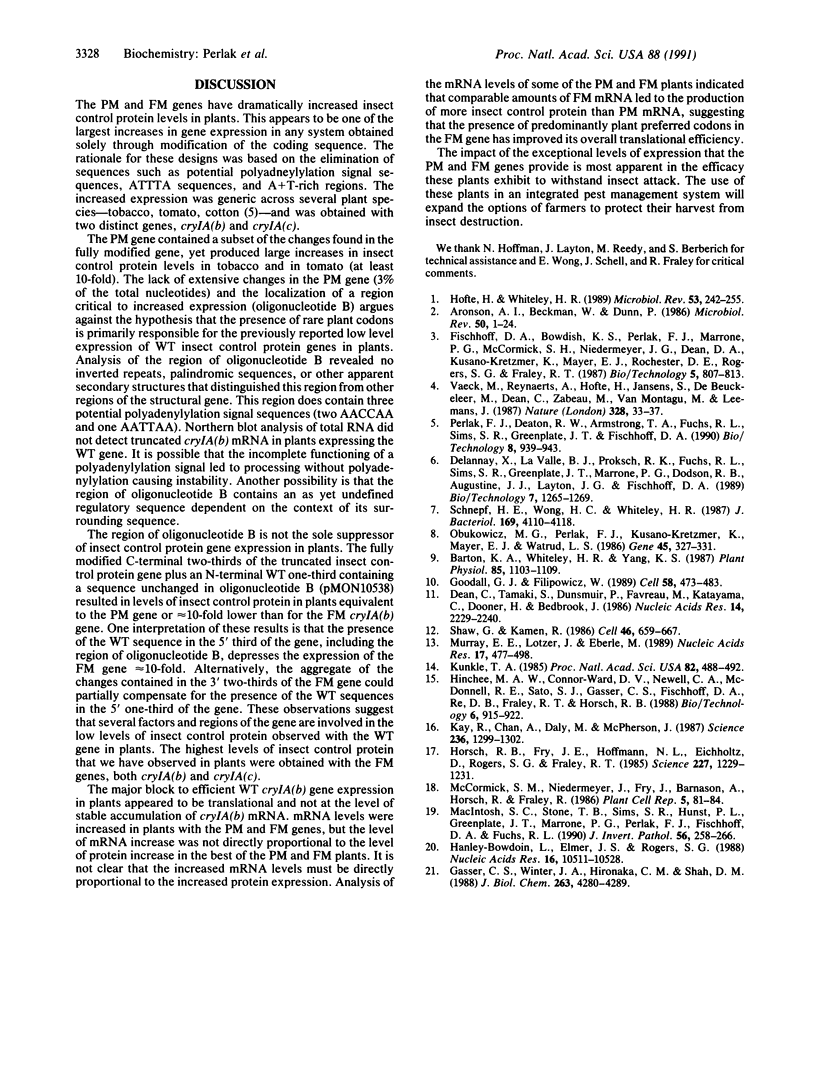
Images in this article
Selected References
These references are in PubMed. This may not be the complete list of references from this article.
- A simple and general method for transferring genes into plants. Science. 1985 Mar 8;227(4691):1229–1231. doi: 10.1126/science.227.4691.1229. [DOI] [PubMed] [Google Scholar]
- Aronson A. I., Beckman W., Dunn P. Bacillus thuringiensis and related insect pathogens. Microbiol Rev. 1986 Mar;50(1):1–24. doi: 10.1128/mr.50.1.1-24.1986. [DOI] [PMC free article] [PubMed] [Google Scholar]
- Barton K. A., Whiteley H. R., Yang N. S. Bacillus thuringiensis section sign-Endotoxin Expressed in Transgenic Nicotiana tabacum Provides Resistance to Lepidopteran Insects. Plant Physiol. 1987 Dec;85(4):1103–1109. doi: 10.1104/pp.85.4.1103. [DOI] [PMC free article] [PubMed] [Google Scholar]
- Dean C., Tamaki S., Dunsmuir P., Favreau M., Katayama C., Dooner H., Bedbrook J. mRNA transcripts of several plant genes are polyadenylated at multiple sites in vivo. Nucleic Acids Res. 1986 Mar 11;14(5):2229–2240. doi: 10.1093/nar/14.5.2229. [DOI] [PMC free article] [PubMed] [Google Scholar]
- Gasser C. S., Winter J. A., Hironaka C. M., Shah D. M. Structure, expression, and evolution of the 5-enolpyruvylshikimate-3-phosphate synthase genes of petunia and tomato. J Biol Chem. 1988 Mar 25;263(9):4280–4287. [PubMed] [Google Scholar]
- Goodall G. J., Filipowicz W. The AU-rich sequences present in the introns of plant nuclear pre-mRNAs are required for splicing. Cell. 1989 Aug 11;58(3):473–483. doi: 10.1016/0092-8674(89)90428-5. [DOI] [PubMed] [Google Scholar]
- Hanley-Bowdoin L., Elmer J. S., Rogers S. G. Transient expression of heterologous RNAs using tomato golden mosaic virus. Nucleic Acids Res. 1988 Nov 25;16(22):10511–10528. doi: 10.1093/nar/16.22.10511. [DOI] [PMC free article] [PubMed] [Google Scholar]
- Höfte H., Whiteley H. R. Insecticidal crystal proteins of Bacillus thuringiensis. Microbiol Rev. 1989 Jun;53(2):242–255. doi: 10.1128/mr.53.2.242-255.1989. [DOI] [PMC free article] [PubMed] [Google Scholar]
- Kay R., Chan A., Daly M., McPherson J. Duplication of CaMV 35S Promoter Sequences Creates a Strong Enhancer for Plant Genes. Science. 1987 Jun 5;236(4806):1299–1302. doi: 10.1126/science.236.4806.1299. [DOI] [PubMed] [Google Scholar]
- Kunkel T. A. Rapid and efficient site-specific mutagenesis without phenotypic selection. Proc Natl Acad Sci U S A. 1985 Jan;82(2):488–492. doi: 10.1073/pnas.82.2.488. [DOI] [PMC free article] [PubMed] [Google Scholar]
- MacIntosh S. C., Stone T. B., Sims S. R., Hunst P. L., Greenplate J. T., Marrone P. G., Perlak F. J., Fischhoff D. A., Fuchs R. L. Specificity and efficacy of purified Bacillus thuringiensis proteins against agronomically important insects. J Invertebr Pathol. 1990 Sep;56(2):258–266. doi: 10.1016/0022-2011(90)90109-j. [DOI] [PubMed] [Google Scholar]
- Murray E. E., Lotzer J., Eberle M. Codon usage in plant genes. Nucleic Acids Res. 1989 Jan 25;17(2):477–498. doi: 10.1093/nar/17.2.477. [DOI] [PMC free article] [PubMed] [Google Scholar]
- Obukowicz M. G., Perlak F. J., Kusano-Kretzmer K., Mayer E. J., Watrud L. S. Integration of the delta-endotoxin gene of Bacillus thuringiensis into the chromosome of root-colonizing strains of pseudomonads using Tn5. Gene. 1986;45(3):327–331. doi: 10.1016/0378-1119(86)90031-4. [DOI] [PubMed] [Google Scholar]
- Perlak F. J., Deaton R. W., Armstrong T. A., Fuchs R. L., Sims S. R., Greenplate J. T., Fischhoff D. A. Insect resistant cotton plants. Biotechnology (N Y) 1990 Oct;8(10):939–943. doi: 10.1038/nbt1090-939. [DOI] [PubMed] [Google Scholar]
- Schnepf H. E., Wong H. C., Whiteley H. R. Expression of a cloned Bacillus thuringiensis crystal protein gene in Escherichia coli. J Bacteriol. 1987 Sep;169(9):4110–4118. doi: 10.1128/jb.169.9.4110-4118.1987. [DOI] [PMC free article] [PubMed] [Google Scholar]
- Shaw G., Kamen R. A conserved AU sequence from the 3' untranslated region of GM-CSF mRNA mediates selective mRNA degradation. Cell. 1986 Aug 29;46(5):659–667. doi: 10.1016/0092-8674(86)90341-7. [DOI] [PubMed] [Google Scholar]



